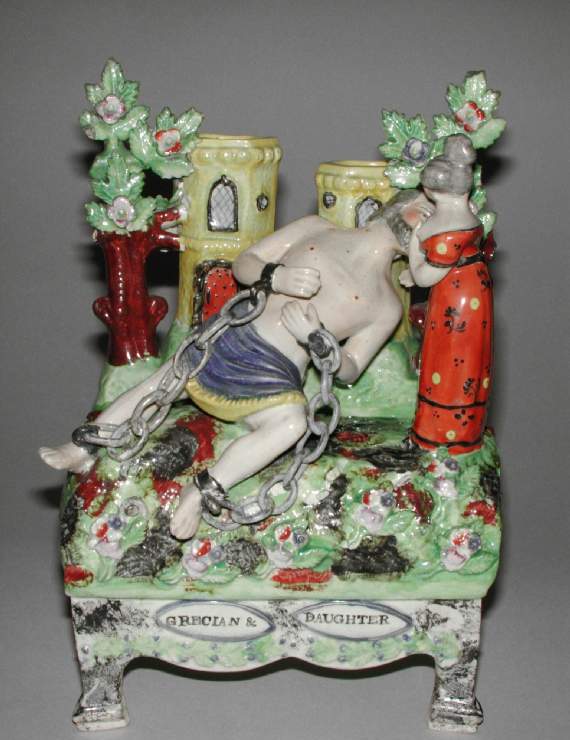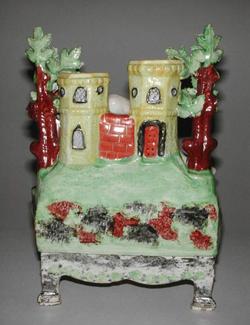Current Location: In storage
Titles
The Roman Charity
Maker(s)
Unidentified Pottery
Entities
Categories
Description
Earthenware table figure group, moulded and modelled, lead glazed and painted with polychrome enamels.
Group representing a girl feeding a prisoner from her breast. The man is naked except for a blue and yellow loin-cloth, his ankles and wrists shackled; he sits on a rocky green brown and grey mound in front of a double-turreted building flanked by trees. The woman, much smaller, wears a red dress with a flower pattern and her grey hair in a top-knot. The base is oblong, with four feet, painted to match the mound above and inscribed ‘GRECIAN &’,
‘DAUGHTER’, impressed into two almond-shaped, applied labels. The building turrets form a double spill-vase. The back is almost flat, though the turrets are described, and painted. The underside of the base is recessed and flat.
Notes
History note: Bought from Mr Stoner, London, on February 21, 1912, with another figure group, for £9.10s (nine pounds ten shillings) the two, by Dr Glaisher, FRS, Trinity College, Cambridge
Legal notes
Dr J. W. L. Glaisher Bequest
Measurements and weight
Height: 24.5 cm
Width: 18 cm
Acquisition and important dates
Method of acquisition: Bequeathed
(1928-12-07)
by
Glaisher, J. W. L., Dr
Dating
19th Century, first half
Circa
1825
-
Circa
1835
Note
Earthenware figure groups were popular from around 1810, although the earliest examples date from nearly a century earlier. A cheaper alternative to porcelain figures, they were often produced by small potteries; very few are marked. Classical or literary subjects were frequently copied from porcelain examples, but potters increasingly turned to scenes from everyday life and topical events. These early figure groups are often complex, including modelled and moulded parts and applied decoration; the backs, though flat, are decorated; bocage (stylised foliage) is common on groups from c.1810-20. However, as demand increased, processes were streamlined to allow mass production and by c.1835 the earlier, relatively costly, methods had largely given way to three-part press-moulding.
Table groups, standing on four or six short legs, were made from c.1825-35; they have similar features, so were probably made by just a few makers. They have in the past been attributed to Obadaiah Sherratt of Burlem, but without clear evidence; they were probably made by a number of figure makers.
The Roman Charity story, of Pero who secretly breastfeeds her imprisoned father, Cimon, is recorded in ancient history and represents both. The scene, which echoes the myth of Juno feeding of the adult Hercules, was depicted by Rubens, Caravaggio and later artists. It symbolises honour and filial piety.
People, subjects and objects depicted
Components of the work
Decoration
composed of
lead-glaze
enamel
Parts
Materials used in production
Earthenware
Inscription or legends present
- Text: ‘GRECIAN &’,‘DAUGHTER’
- Location: On front of base
- Method of creation: Impressed into two almond-shaped, applied labels
- Type: Label
References and bibliographic entries
Identification numbers
Accession number: C.970-1928
Primary reference Number: 76472
Stable URI
Audit data
Created: Saturday 6 August 2011
Updated: Monday 29 April 2024
Last processed: Tuesday 15 July 2025
Associated departments & institutions
Owner or interested party:
The Fitzwilliam Museum
Associated department:
Applied Arts





